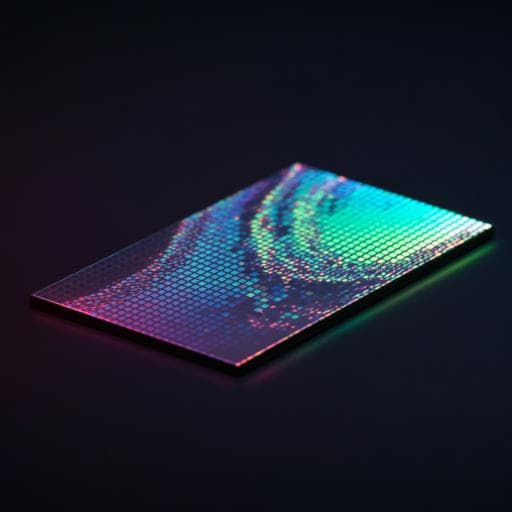
Engineering and Technology
Electrically-controlled digital metasurface device for light projection displays
J. Li, P. Yu, et al.
Explore the groundbreaking digital metasurface devices (DMSDs), developed by Jianxiong Li, Ping Yu, Shuang Zhang, and Na Liu, that revolutionize light projection with their ability to dynamically switch between diverse holographic patterns. This technology paves the way for customized, high-contrast light projection applications.
~3 min • Beginner • English
Introduction
The rapid progress of nanophotonics motivates new concepts and device designs for diverse optical applications. Metasurfaces—ultrathin arrays of subwavelength antennas—enable flat optical elements with unprecedented control over light propagation, leading to beam deflectors, wave plates, flat lenses, displays, holograms, and surface-wave couplers. Despite advances, dynamically reconfigurable optical metasurfaces—crucial for real-world applications—remain underdeveloped, often limited to uniform tuning of resonance frequency or amplitude across all elements, with low intensity modulation and narrow bandwidth, especially at visible frequencies. This work demonstrates a strategy to realize dynamic optical metasurfaces by tailoring spatial frequencies via modulation of geometric and propagation phases at visible wavelengths. The authors introduce electrically controlled digital metasurface devices (DMSDs) comprising an M×N array of metasurface pixels. Each pixel contains gold nanorods arranged in columns, with selected columns covered by a dielectric, and the sample encapsulated in a thin liquid-crystal cell. By electrically controlling the relative phase between neighboring column sets, each pixel can be switched between bright and dark states and can generate programmable anomalous reflection spots or arbitrary holographic patterns, enabling dynamic light projection displays.
Literature Review
Prior work has established metasurfaces for diverse static optical functions such as beam steering, polarization control, flat lenses, displays, and holography. Dynamic control of metasurfaces has been explored using mechanical, chemical, electrical, thermal, and magnetic stimuli. However, most approaches tune all antennas simultaneously and are constrained by low-intensity modulation and narrow operating bands, particularly in the visible. The present study advances dynamic metasurfaces by combining geometric (Pancharatnam–Berry) and propagation phase control to tailor spatial frequency content and realize independently addressable pixels with high-contrast intensity modulation and dynamic wavefront shaping.
Methodology
Design and operating principle: The device employs spatial-frequency modulation by imposing a discrete phase distribution across columns of elements in each metasurface pixel. Neighboring odd and even columns differ by a controllable phase offset Δφ, while a linear geometric phase gradient is introduced along columns via orientation of gold nanorods. Discrete Fourier analysis shows two spatial-frequency components: a low-frequency propagating component producing anomalous reflection and a high-frequency evanescent component. Varying Δφ transforms energy between these components: anomalous reflection diminishes and vanishes at Δφ = π (destructive interference), and re-emerges at Δφ = 2π.
Phase control: Δφ is realized by combining geometric phase (Δφg) from antenna orientation (PB phase) and propagation phase (Δφρ) from dielectric overcoatings. For PB-only control, varying the inter-column angle difference modulates anomalous reflection, with complete suppression at Δφg = π. Adding dielectric coatings on alternating columns provides Δφρ tunability: gold nanorods (200 nm × 80 nm × 30 nm) on a Au/SiO2 substrate (100 nm SiO2) are embedded in a 50 nm spacer (n = 1.5), and alternating columns are covered by materials with refractive indices na and nb to tune Δφρ and thus the anomalous reflection continuously.
Device architecture (DMSD): For experimental DMSDs, arrays of gold nanorods are fabricated on a gold electrode and embedded in PC403 polymer (100 nm base layer; 50 nm overcoat). Alternating columns are covered by either high-birefringence liquid crystals (LCs) or PMMA trenches (thickness t ≈ 240 nm). A rubbed polyimide alignment layer is oriented along the PMMA trenches; the LC cell is sealed with an ITO-coated quartz superstrate serving as a shared electrode. The device is driven with a 1 kHz AC sine voltage to reduce ion migration. Incident light at 633 nm is linearly polarized along the PMMA trenches.
Operation states: With no applied voltage, LC long axes align along the trenches, giving ne ≈ 1.92 and nb = nPMMA ≈ 1.5; choosing t ≈ 240 nm yields Δφ = Δφg + Δφρ ≈ 2π, producing a bright anomalous reflection (logical “1”). Increasing voltage reorients LCs, decreasing the effective index toward no ≈ 1.53 ≈ nPMMA, setting Δφ ≈ π and extinguishing the anomalous reflection (logical “0”).
Pixel configurations and demonstrations: A 4-bit DMSD with four independently addressable pixels (M1–M4) was fabricated, generating programmable patterns (“1111,” “0111,” etc.) by switching pixels on/off. A seven-pixel numeric indicator was also realized, where each pixel produces a holographic segment; by addressing combinations of segments, digits 1–9 (and 0, though not shown) are dynamically projected. For dynamic holography, a metasurface multiplexed two phase profiles (subunit cells I and II) designed via the Gerchberg–Saxton algorithm to produce off-axis “stop” and “walk” holograms. In each subunit, orthogonal nanorods (both in PC403) are used; one rod per subunit is covered by PMMA (n ≈ 1.5) or HfO2 (n ≈ 1.94). Voltage tuning switches between holograms: at 0 V the “stop” image appears (I on, II off), at 30 V the “walk” image appears (I off, II on), and at intermediate voltage both are visible.
Fabrication: Multi-step electron-beam lithography on quartz defines electrodes and markers (Cr 5 nm/Au 100 nm), followed by PC403 coating (100 nm) with multi-temperature bakes. Nanorods (Cr 2 nm/Au 30 nm) are patterned via aligned EBL and lift-off, followed by a 50 nm PC403 overcoat. PMMA grating trenches are fabricated by EBL; HfO2 coatings where needed are deposited by e-beam evaporation and lift-off. The LC cell is assembled with a rubbed-polyimide ITO glass, UV-curable glue with 5 μm spacers, filled with LCM1107 LC at 120 °C, and cooled to room temperature.
Optical characterization: For projection measurements, a laser at 633 nm, polarizer, and imaging optics project anomalous reflection or reconstructed holograms onto a screen for camera capture. Voltage-dependent intensity is recorded to quantify modulation. Cycling tests assess reversibility and stability.
Numerical simulations: COMSOL Multiphysics (finite element method) with periodic boundary conditions on a supercell, a waveguide port for normally incident circularly polarized light, and perfectly matched layers top/bottom. Mesh size 10 nm; substrate included; n(SiO2) = 1.5; Au permittivity from Palik. Simulations compute anomalous reflection intensity versus Δφ and dielectric indices.
Key Findings
- Demonstrated electrically controlled DMSDs at 633 nm with independently addressable metasurface pixels that modulate both intensity and wavefront.
- Spatial-frequency control via Δφ = Δφg + Δφρ enables continuous tuning of anomalous reflection; complete off at Δφ = π and on at Δφ = 2π, transforming energy between propagating and evanescent components as predicted.
- 4-bit DMSD produced programmable far-field projection patterns with high contrast; measured intensity modulation ratio up to 105:1 between on and off states.
- Switching times: approximately 40 ms (“0” state) and 65 ms (“1” state). Cycling stability: no evident signal degradation up to 100 cycles.
- Only LC within subwavelength PMMA trenches contributes to Δφρ, enabling in-principle subwavelength device thickness.
- Seven-pixel numeric indicator display generated digits dynamically by switching holographic segments on/off in a single device.
- Electrically switchable dynamic holography between two arbitrary images (“stop” and “walk”) realized via multiplexed phase profiles; voltage tuning (0 V, 5 V, 30 V) selects individual or combined holograms.
- Experiments agree with simulations for intensity versus voltage/index tuning, validating the design approach.
Discussion
The work addresses the need for dynamic, addressable, visible-frequency metasurfaces by introducing a pixelated platform that tailors spatial frequencies through combined geometric and propagation phase modulation. By electrically controlling the relative phase across alternating columns within each pixel, the device achieves high-contrast on/off anomalous reflection and dynamic wavefront shaping with millisecond response. The results demonstrate that metasurfaces can act as digitally addressable projectors and holographic displays, bridging static metasurface optics and practical display technologies. The approach is versatile: while liquid crystals provide effective refractive-index tuning here, the same principle can be applied to other active media responsive to electrical, optical, thermal, or chemical stimuli, broadening applicability. The agreement between simulations and experiments underpins the robustness of the spatial-frequency engineering concept, and the demonstrated addressability, switching performance, and holographic programmability highlight the relevance for scalable, customized light projection and dynamic holography.
Conclusion
This study introduces electrically controlled digital metasurface devices that use combined geometric and propagation phase modulation to dynamically control spatial frequencies, enabling high-contrast, addressable projection and arbitrary dynamic holography at visible wavelengths. Key contributions include a 4-pixel projector with 105:1 modulation contrast and millisecond switching, a seven-segment numeric indicator, and switchable dual-image holography. The concept is universal and compatible with various active materials beyond liquid crystals, opening pathways to compact, fast, and customizable light projection systems. Future research could scale the pixel count and density, optimize materials and geometries to further reduce switching times and operating voltages, extend operation across broader spectral ranges, and integrate alternative active media for improved speed and stability.
Limitations
- Demonstrations involve a limited number of pixels (4-bit and 7-segment devices); large-scale arrays and addressing schemes remain to be shown.
- Operation is demonstrated at a single wavelength (633 nm) and with specific input polarization, which may limit spectral and polarization flexibility without additional design.
- Switching speed is bounded by LC response (tens of milliseconds); faster operation would require thinner LC regions or alternative active materials.
- Device performance depends on precise nanofabrication and material uniformity (e.g., trench thickness, alignment), which may affect scalability and yield.
- The effective modulation relies on index matching/mismatch between alternating columns; environmental or temperature variations could impact refractive indices and stability.
Related Publications
Explore these studies to deepen your understanding of the subject.







